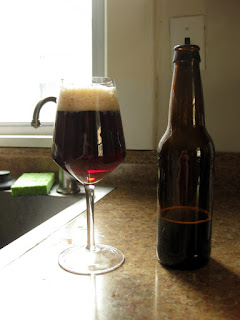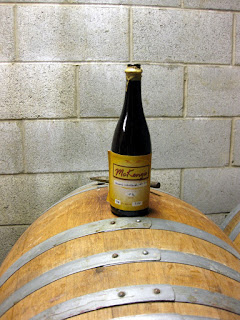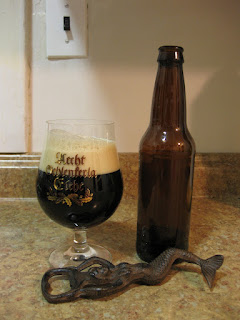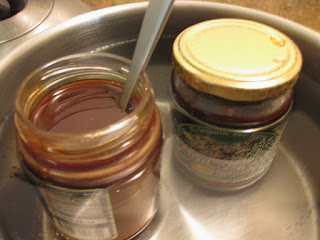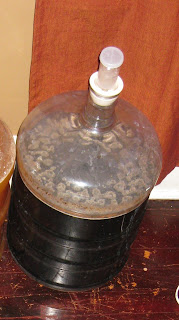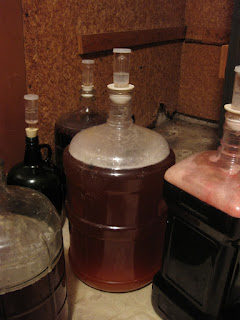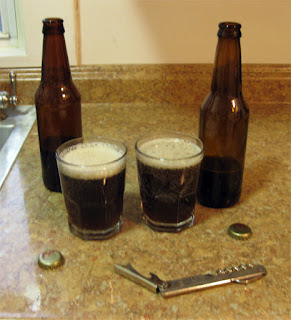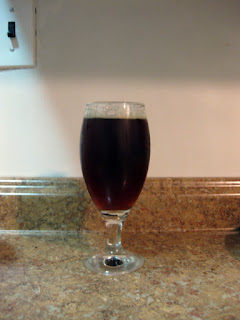I first sampled Russian River's Pliny the Younger at a BeerAdvocate American Beer Fest about five years ago. I've had samples of it a couple more times since that night, mostly from growlers, but that first sip left an indelible stamp on my tongue. The hop flavor was dominant, with complex citrus and fresh pine, while the beer was still remarkably smooth and easy to drink. Over the last few years I've made a handful of attempts at replicating PtY using information gleaned from talks, articles, and emails from Vinnie; the beers were good, but not quite there.
 After I finally bought a kegging system last year, my hoppy beers got considerably better. I credit a couple techniques that kegs allow me to do for this improvement. The ability to flush the keg with CO2, which reduces oxidation preserving a fresher hop character. Keg hopping, which allows the beer to remain in contact with the dry hops until second before serving. Force carbonation, which enables quicker, more reliable carbonation of strong beers. With the kegs (not to mention the moratorium on Younger growler sales this year) I thought it was time to give a clone another shot.
After I finally bought a kegging system last year, my hoppy beers got considerably better. I credit a couple techniques that kegs allow me to do for this improvement. The ability to flush the keg with CO2, which reduces oxidation preserving a fresher hop character. Keg hopping, which allows the beer to remain in contact with the dry hops until second before serving. Force carbonation, which enables quicker, more reliable carbonation of strong beers. With the kegs (not to mention the moratorium on Younger growler sales this year) I thought it was time to give a clone another shot.
I've learned to anticipate 20% lower efficiency when brewing a big IPA as a result of the huge amount of wort lost to the hops. I used half a sack of Great Western 2-row (paler than their pale malt) along with a small amount of carapils (for added body). I mashed just under 150 to ensure the targeted 85% attenuation of the original. The high attenuation keeps this beer firmly in the DIPA category where a sweeter beer would come across as an American barleywine.
The other big change I made was switching to hop extract for part of the bittering addition. Extract adds IBUs without contributing vegetal matter to the kettle, which steals wort and can give grassy flavors at high levels. I was originally planning to derive all the bitterness form extract (20 ml), but right before brewing I realized that the two Northern Brewer HopShots I purchased were 5 ml each not 10 ml; I decided to add 2 oz of Columbus to augment the bitterness from the extract.
 For hop aromatics I added a total of 9 oz of Amarillo/Centennial/Simcoe at the end of the boil (with 3 oz of the blend at flameout, at the start of chilling, and three minutes into chilling). I stirred the wort continually as it cooled to speed up the cooling process, reducing the amount of hop aromatics driven off. I've had the best luck using pellets for late additions since they contribute their flavor quicker than whole hops, and don't suck up quite as much wort.
For hop aromatics I added a total of 9 oz of Amarillo/Centennial/Simcoe at the end of the boil (with 3 oz of the blend at flameout, at the start of chilling, and three minutes into chilling). I stirred the wort continually as it cooled to speed up the cooling process, reducing the amount of hop aromatics driven off. I've had the best luck using pellets for late additions since they contribute their flavor quicker than whole hops, and don't suck up quite as much wort.
With the wort cooled I pitched a decanted starter of White Labs 001, the same strain Vinnie uses for his hoppy beers. He has suggested not pitching "too much" yeast as the cells will strip out some of the bitterness from the beer. Not knowing exactly what this meant and not wanting to stress the yeast, I made a 2.5 qrt starter, a bit short of the 4 qrt starter that yeast pitching calculators suggest for a beer this gravity. Luckily fermentation started after 12 hours, and was going strong after 24. My basement is in the high 50s this time of year, perfect for keeping the strong fermentation just below 70 degrees.
To help boost the attenuation, Pliny the Younger includes some easily fermented refined sugar. I could have added this to the kettle, but I wanted to cut the yeast a break and give them time to reduce the gravity of the wort significantly before adding the cane/corn sugars. Too much osmotic pressure from concentrated sugars can put a lot of stress on yeast (enough sugar can exert so much pressure that it make a liquid shelf-stable, as in the cases of honey and maple syrup).
The original dry hops schedule (at the bottom of the post) calls for four separate dry hop additions. That sounds like too much time/effort/risk for me, so I simplified to one dry hop addition and one keg hop. The same amount/timing worked well on the great Double IPA I brewed last winter, so it seems like a good idea for this one.
Hoping to have a party when this one is ready since this is a beer best consumed quickly (and for safety reasons not all by me).

Pliny the Younger Clone
Recipe Specifics
-----------------
Batch Size (Gal): 5.25
Total Grain (Lbs): 27.19
Anticipated OG: 1.094
Anticipated SRM: 6.6
Anticipated IBU: 199.5
Brewhouse Efficiency: 48 % (65% including second runnings).
Wort Boil Time: 95 Minutes
Grain/Sugar
------------
92.0% 25.00 lbs. American 2-row
3.7% 1.00 lbs. Corn Sugar
3.5% 0.94 lbs. CaraPils
0.9% 0.25 lbs. Cane Sugar
Hops
------
10 ml HopShot @ 90 min.
2.00 oz. Columbus (Pellet 13.00% AA) @ 60 min.
4.00 oz. Amarillo (Pellet, 6.90% AA) @ 0 min.
3.00 oz. Centennial (Pellet, 8.80% AA) @ 0 min.
2.00 oz. Simcoe (Pellet, 12.20% AA) @ 0 min.
Dry Hops
1.00 oz. Amarillo (Whole, 10.00% AA)
1.00 oz. Centennial (Whole, 10.50% AA)
1.00 oz. Simcoe (Whole, 14.00% AA)
Keg Hops
1.00 oz. Amarillo (Whole, 10.00% AA)
1.00 oz. Centennial (Whole, 10.50% AA)
1.00 oz. Simcoe (Whole, 14.00% AA)
Extras
-------
0.50 Unit Wirlfloc @ 12 min.
0.50 tsp Yeast Nutrient @ 12 min.
Yeast
------
White Labs WLP001 California Ale
Water Profile
-------------
Profile: Pliny the Water
Mash Schedule
----------------
Sacc Rest 15 min @ 143
Sacch II 60 min @ 149
Sacch III 5 min @ 156
Notes
-----
12/14/10 2.5 qrt starter made, crash chilled to 37 three days later
Brewed 12/19/10
Mash water 4.5 gallons filtered DC plus 3 gallons distilled, 7 g gypsum.
Initial mash temp was a bit low, heated up some water and boosted the temp closer to the 150 I was initially aiming for. 2.5 gallons (inc 1 gallon distilled and 3 g gypsum) added before the wort was run off.
About 1 gallon short on pre-boil wort, so I stole 1 gallon of runnings from the small beer.
Totaled 8 gallons pre boil ~1.065.
3 oz of hops at flameout, waited 5 min before starting the chill, added 3 oz more hops after about a minute, waited 3 minutes added final dose of 3 oz of hops. Cold ground water ~50 F, lots of stirring, cooled quickly.
The mash was capped and I used the second runnings to make an American Bitter.
1.084 post-boil, pre-sugar.
Chilled to ~64, strained, pitched the decanted room-temp starter, and gave 60 seconds of oxygen. Left at ~63 ambient to start fermentation.
Good fermentation after 24 hours, moved to ~59 ambient.
12/21/10 Measured fermentation temp at 68, which is spot on for what Vinnie suggests.
12/22/10 Added the sugars boiled in 1 pint of filtered water for a few minutes to dissolve. Cane/corn sugar represent 11% of the fermentables by extract.
12/28/10 Down to 1.014, 85% AA, 10.6% ABV. Right on target. Krausen already dropped, but I'll give it a few more days to ensure the fermentation is complete before racking. Nice lingering bitterness, nice aroma, but despite the huge late hop addition the citrus/pine/tropical aroma isn't as powerful as I expected (the dry hops will fix that).
12/31/10 Flushed a sanitized keg twice with CO2, pumped the auto-siphon in the keg, then flushed the keg again. Racked to ~4.75 gallons of the beer into the keg, then sealed it up and flushed the headspace two more times. Left at cool room temp for a day or two more before chilling.
1/2/11 Moved the keg to 35 degree fridge to help the yeast flocc out before adding the first dry hop addition.
1/10/11 Moved keg out of the fridge, allowed to warm for a few hours, drained 1 pint of yeast/trub through a tap, added the first addition of dry hops (weighed down by marbles). Left at room temp ~64 F. Beer tastes good, firm bitterness, but not nearly enough hop aromatics.
1/26/11 Removed first dry hop addition, added second dose. Moved to kegerator and hooked up to CO2, vented, and left to carbonate. Hopefully ready for a sample in two weeks.
3/1/11 About as close as I could expect to get without getting the exact details from Vinnie. Could be slightly drier, and a bit danker, but it has a hugely complex pine/citrus nose and loads of bitterness. Well worth trying if you have an iron liver or lots of hophead friends.
-------------------------------------
Actual dry hop schedule per Vinnie.
DH 1 Simcoe, Amarillo, Centennial for one week and remove
DH 2 Amarillo, Centennial for one week and remove
DH 3 Simcoe for one week and remove
DH 4 Simcoe, Amarillo Dry Hop in Keg
I think an ounce of each of the hops at each addition would be about right if you want to go this route.
